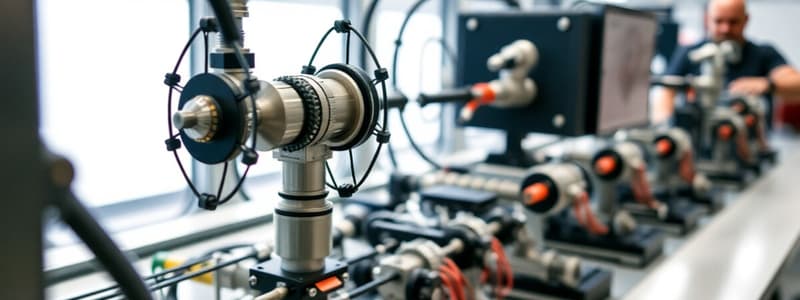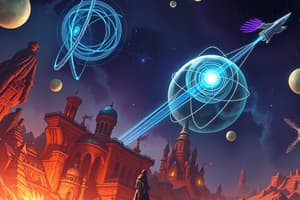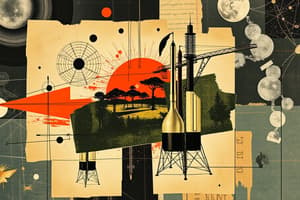Podcast
Questions and Answers
What role did the Gutenberg Printing Press play in society?
What role did the Gutenberg Printing Press play in society?
- It was responsible for significant scientific accomplishments during the Middle Ages.
- It made books more expensive and rare.
- It initiated the fall of the Roman Empire.
- It led to the birth of the industrial revolution by enabling mass production of written works. (correct)
Which of the following scientists is associated with the Heliocentric Theory?
Which of the following scientists is associated with the Heliocentric Theory?
- Isaac Newton
- Johannes Kepler
- Nicolaus Copernicus (correct)
- Galileo Galilei
What was a significant impact of the Black Death during the Medieval Ages?
What was a significant impact of the Black Death during the Medieval Ages?
- It resulted in the production of great art.
- It marked a period with no great leaders born. (correct)
- It led to the rise of scientific accomplishments.
- It caused a surge in book manufacturing.
Which invention is credited to James Watt during the First Industrial Revolution?
Which invention is credited to James Watt during the First Industrial Revolution?
Which period saw the establishment of the National Grains Authority?
Which period saw the establishment of the National Grains Authority?
What was a significant characteristic of book production in the Middle Ages?
What was a significant characteristic of book production in the Middle Ages?
How did scientific and technological advancements historically affect society?
How did scientific and technological advancements historically affect society?
What was one of the contributions of the Suez Canal during the Spanish Colonial Period?
What was one of the contributions of the Suez Canal during the Spanish Colonial Period?
What significant legislation aimed to promote free secondary education was enacted during Corazon Aquino's presidency?
What significant legislation aimed to promote free secondary education was enacted during Corazon Aquino's presidency?
Which of the following initiatives is NOT attributed to President Gloria Arroyo's administration?
Which of the following initiatives is NOT attributed to President Gloria Arroyo's administration?
Which national scientist was recognized for extensive studies on seaweed species during Benigno Simeon Aquino III's presidency?
Which national scientist was recognized for extensive studies on seaweed species during Benigno Simeon Aquino III's presidency?
Which invention is attributed to Dr. Fe Del Mundo?
Which invention is attributed to Dr. Fe Del Mundo?
What act was introduced during Joseph Estrada's presidency focused on environmental protection?
What act was introduced during Joseph Estrada's presidency focused on environmental protection?
Which invention originated from Gregorio Zara in 1955?
Which invention originated from Gregorio Zara in 1955?
The Intellectual Property Code was established during which presidency?
The Intellectual Property Code was established during which presidency?
Which Filipino inventor is known for creating the Lunar Rover in 1969?
Which Filipino inventor is known for creating the Lunar Rover in 1969?
Flashcards
Free Public Secondary Education Act of 1988
Free Public Secondary Education Act of 1988
A law that included a program promoting science education for the general public.
Magna Carta for Science and Technology Personnel
Magna Carta for Science and Technology Personnel
A document that recognizes and supports scientists and researchers.
Philippine Clean Air Act of 1999
Philippine Clean Air Act of 1999
Law created to improve air quality in the Philippines.
Electronic Commerce Act of 2000
Electronic Commerce Act of 2000
Signup and view all the flashcards
Biofuels Act
Biofuels Act
Signup and view all the flashcards
National Scientists of the Philippines
National Scientists of the Philippines
Signup and view all the flashcards
Filipino Inventors/Inventions
Filipino Inventors/Inventions
Signup and view all the flashcards
Science High Schools in Visayas and Mindanao
Science High Schools in Visayas and Mindanao
Signup and view all the flashcards
Science and Technology interactions
Science and Technology interactions
Signup and view all the flashcards
Ancient civilizations and science
Ancient civilizations and science
Signup and view all the flashcards
Gutenberg Printing Press
Gutenberg Printing Press
Signup and view all the flashcards
Scientific Revolution
Scientific Revolution
Signup and view all the flashcards
First Industrial Revolution
First Industrial Revolution
Signup and view all the flashcards
Banaue Rice Terraces
Banaue Rice Terraces
Signup and view all the flashcards
Philippine government science agencies
Philippine government science agencies
Signup and view all the flashcards
Paradigm Shifts
Paradigm Shifts
Signup and view all the flashcards
Study Notes
Unit 1 - General Concepts and STS Historical Developments
- Objectives: The unit aims to discuss science and technology's interaction with society throughout history, analyzing how these developments affect both society and the environment. It will also explore paradigm shifts, societal transformations, and the contributions of various civilizations to science and technology. Crucially, this unit covers how Philippine nation-building has been influenced by science and technology policy. Students will evaluate government policies, identify specific policies, and analyze their impact on the nation's progress.
Ancient Times
- Interactions: Early societies used their experiences to develop knowledge and improve their lives. This involved exploration and a search for greater comfort.
Ancient Civilizations of the World
- Advancements: The birth of civilizations brought advancements in science and technology, supported by evidence.
Medieval or Dark Ages
-
Decline: The period after the fall of Rome was a time of perceived stagnation in scientific and technological progress.
-
Examples: The Black Death, lack of great leaders or significant artistic creations are cited as indicators of this decline.
Middle Ages & Books
- Scarcity: Books were costly and rare, needing to be meticulously copied by hand. Each page had to be individually handwritten.
Gutenberg Printing Press
-
Revolution: Johannes Gutenberg's invention of the printing press brought mass production to written works, empowering wider dissemination of knowledge.
-
Impact: This development aided information accessibility and spurred the Industrial Revolution.
Revolutionary Discoveries in Modern Ages
-
Heliocentric Theory: Nicolaus Copernicus' heliocentric theory revolutionized astronomical thinking.
-
Law of Gravity: Isaac Newton's law of gravity explained the Moon's orbit and other celestial movements.
Galileo's Concept of Inertia
-
Motion: Galileo's discoveries about motion and inertia challenged previous theories.
-
Key Concepts: Through observation of rolling balls, Galileo established that a body in motion on a frictionless surface will maintain that motion indefinitely.
First Industrial Revolution
- Key Inventions: James Watt's steam engine and Edmund Cartwright's mechanical loom were vital inventions of this period.
First, Second, Third and Fourth Industrial Revolutions
- Progression: The First Industrial Revolution utilized steam and water power, the Second utilized electricity, the Third utilized information technologies and electronics, and the Fourth involves cyber-physical systems melding physical, digital, and biological aspects.
Pre-Spanish Period
- Banaue Rice Terraces: An example of remarkable engineering and agricultural achievements from the pre-Spanish era in the Philippines.
Spanish Colonial Period
- Influence: The Spanish colonial period introduced elements of science and technology to the Philippines while the Suez Canal fostered global trade.
American Period and Post-Commonwealth Era
- Bureaucracy: The establishment of government agencies like bureaus of government laboratories and institutes of science during this period fostered science and technology advancements.
Marcos Era and Martial Law
- Science Agencies: Government agencies like the National Grains Authority, PAGASA, and the National Academy of Science and Technology were established during this era.
The Fifth Republic - Pres. Corazon Aquino's Presidency
- Education: The Free Public Secondary Education Act introduced "Science for the Masses Program," furthering science education.
Fidel V. Ramos Presidency
- National Developments: Key national developments include establishment of a science high school and the Magna Carta for Science and Technology Personnel.
Pres. Joseph Estrada Presidency
- Legal Frameworks: The Philippine Clean Air Act of 1999 and the Electronic Commerce Act of 2000 represent notable legislation during this time.
President Gloria Arroyo Presidency
- "Golden Age" of STS: This period is characterized by a "Golden Age" for science and technology in the Philippines, reflecting a combined emphasis on innovation, environment-focused efforts, and science-based initiatives
Pres. Benigno Simeon C. Aquino III Presidency
- National Scientists: Four new National Scientists were recognized for their outstanding contributions in their respective scientific fields. (Trono, Alcala, Barba, Gomez)
Some Filipino Inventors and Inventions
- Filipino inventors' various contributions to scientific fields are explored, such as the Yoyo, Banana Catsup, Medical Incubator, Patis, Erythromycin, Video Phone, Isolated Rice Breeds, Lunar Rover, 16-bit Computer Microchip, Sing-A-Long System, Alco Diesel, Anti-cancer cream.
Studying That Suits You
Use AI to generate personalized quizzes and flashcards to suit your learning preferences.
Related Documents
Description
This quiz covers the interaction between science, technology, and society throughout history, focusing on paradigm shifts and societal changes. It explores the contributions of ancient civilizations and the impact of science and technology on Philippine nation-building. Students will evaluate key government policies and their influence on progress.




